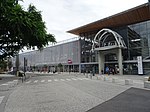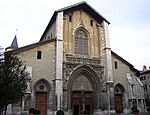Canton of Chambéry-1
Cantons of SavoieSavoie geography stubs
The canton of Chambéry-1 is an administrative division of the Savoie department, southeastern France. It was created at the French canton reorganisation which came into effect in March 2015. Its seat is in Chambéry.It consists of the following communes: Chambéry (partly) Sonnaz
Excerpt from the Wikipedia article Canton of Chambéry-1 (License: CC BY-SA 3.0, Authors).Canton of Chambéry-1
Chemin de Charrière Neuve, Chambéry Bissy
Geographical coordinates (GPS) Address Nearby Places Show on map
Geographical coordinates (GPS)
| Latitude | Longitude |
|---|---|
| N 45.58 ° | E 5.9 ° |
Address
Chemin de Charrière Neuve
Chemin de Charrière Neuve
73000 Chambéry, Bissy
Auvergne-Rhône-Alpes, France
Open on Google Maps







